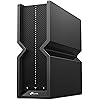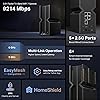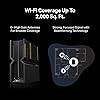







Ready to go? Add this product to your cart and select a plan during checkout. Payment plans are offered through our trusted finance partners Klarna, PayTomorrow, Affirm, Afterpay, Apple Pay, and PayPal. No-credit-needed leasing options through Acima may also be available at checkout.
Learn more about financing & leasing here.
30-day refund/replacement
To qualify for a full refund, items must be returned in their original, unused condition. If an item is returned in a used, damaged, or materially different state, you may be granted a partial refund.
To initiate a return, please visit our Returns Center.
View our full returns policy here.
Style: BE9300
Features
Description
Redefining Wi-Fi Routers With Wi-Fi 7Supercharged by the latest WiFi 7 technology, Archer BE550 takes your WiFi network's power and efficiency further than ever. Delivering unbelievable speeds up to 9.2 Gbps on a tri-band channel with WiFi 7 exclusive features like 320 MHz channel and 4K-QAM, the Archer BE550 will crush its competition with sheer performance. 6 x smart optimized antennas provide stable and reliable connection while EasyMesh compatibility will aid in the future expansion of your network coverage. The full 2.5 Gbps ports ensure maximum expandability and capacity while HomeShield provides detailed network analytics with enhanced security for your home network.
Brand: TP-Link
Model Name: Archer BE550
Special Feature: QoS, Access Point Mode, Guest Mode, WPS, Remote Access
Frequency Band Class: Tri-Band
Wireless Communication Standard: 802.11n, 802.11ax, 802.11ac, 802.11g, 802.11.be
Compatible Devices: Gaming Console, Personal Computer, Tablet, Smart Television, Smartphone
Frequency: 6 GHz
Recommended Uses For Product: Gaming, Home
Included Components: Power Adapter, RJ45 Ethernet Cable, Quick Installation Guide, Wi-Fi 7 Router Archer BE550
Connectivity Technology: Wi-Fi (802.11ac, 802.11ax, 802.11n, 802.11g, 802.11be), Ethernet, USB
Product Dimensions: 9.12 x 2.99 x 7.99 inches
Item Weight: 2.45 pounds
Item model number: Archer BE550
Date First Available: October 12, 2023
Manufacturer: TP-Link
Country of Origin: Vietnam